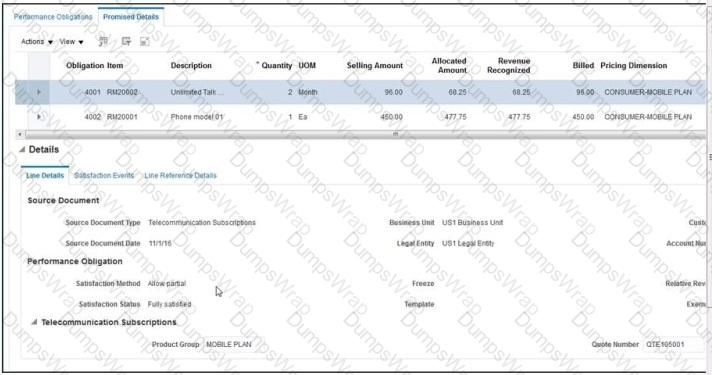Oracle Revenue Management Cloud Service 2024Implementation Essentials Questions and Answers
Which, when transferred to a customer, allows you to recognize revenue?
The Contracts Requiring Attention user Interface has three tabs: Pending Review, Pending Allocation, and Pending Revenue Recognition.
What would cause a contract to be In the Pending Review tab?
Before uploading Estimated Standalone Selling Prices (SSP), you must populate a spreadsheet with some required data.
Besides Unit SSP Price, Currency and Unit of Measure, which three additional attributes are required when loading prices for items, memo lines and/or Item groups?
Given your organization's Interactions with one of Its customers:
A consultant is deployed to assist customer on 10-Sep-2017.
A Sales order is booked on 14-Sep-2017.
The Product is shipped on 15-Sep-2017.
An Invoice is issued on 20-Sep-2017.
When do you accrue the contract liability?
Which statement does NOT describe how revenue is handled under the latest standards under ASC 606 and IFRS 15?
A pricing dimension segment value combination is one of the factors to determine standalone selling prices. This combination is based on the pricing dimension assignment setup.
What does the pricing dimension assignment match the pricing dimension segment combination to?
How many tabs does the Customer Contract Source Data Import Template have?
Your organization Is selling a warranty plan to customers that covers appliances for one year. Revenue must be recognized gradually by month until the warranty expires.
Which Revenue Scheduling Rule Type needs to be defined for the Performance Satisfaction Plan?
A corporation uses a primary ledger with a currency of USD. The organization's data includes source document lines with amounts expressed in the Euro currency. However, Revenue Management calculates transaction totals, allocations, and creates accounting in the ledger currency.
What needs to be done in Revenue Management to convert transaction amounts to the USD currency?
Given the Standalone Selling Price Profile combines all the key setup attributes of pricing Into one place, you create all standalone selling prices from the Standalone Selling Price Profiles for all Items or groups of items.
Which three setup attributes are part of a Standalone Selling Price Profile?
When deciding how to set up the system to recognize revenue, it is important to understand the extent of revenue deferral and the subsequent timing of revenue recognition. Which two statements are true when you
consider that recognition depends on the nature of the contingency? (Choose two)
Which is NOT a Price Band Type?
Which statement Is True regarding the Customer Contract Source Data Import Template?
Given It Is critical to capture common link values In one or more attributes on the source document lines in order to build effective Performance Obligation Identification Rules, how many User Extensible Fields does Revenue Management provide to facilitate the capture of this data?
65-A business entity (your client) sells a computer, monitor, keyboard, and mouse as a single package to consumers. The entity has identified that this bundle is a distinct performance obligation. How would you
configure the Performance Obligation Identification Rule to ensure correct grouping of these items?


What is the correct match sequence of the descriptions A, B and C against the titles?
A business entity (your client) sells a computer, monitor, keyboard, and mouse as a single package to consumers. The entity has identified that this bundle is a distinct performance obligation. How should you configure
Revenue management to ensure that these items are grouped into one performance obligation?
The predefined Revenue Contract Account Activities Report provides data extracted from which two sources?
After defining a pricing dimension structure for a customer, you must define a pricing dimension structure instance. Which two attributes on the structure instance are inherited from the structure definition?
Which three tasks are associated with defining a Pricing Dimension Structure?
Which three attributes are helpful in defining a Contract Identification Rule?
Which two settings are related to the "Invalid Line Handling" Revenue Management System Option?
The contract Promised Details tabs includes Selling Amount, Allocated Amount, Revenue Recognized, and Bill…….

What is the difference between Selling Amount and Allocated Amount?
A furniture store is running a promotion for a toaster with the purchase of a sofa or chair set. Data about the free toaster is not captured in any upstream application.
How should you handle this scenario In Revenue Management?

